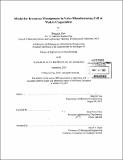| dc.contributor.advisor | Jung-Hoon Chun. | en_US |
| dc.contributor.author | Yao, Bingxin | en_US |
| dc.contributor.other | Massachusetts Institute of Technology. Department of Mechanical Engineering. | en_US |
| dc.date.accessioned | 2014-03-06T15:49:39Z | |
| dc.date.available | 2014-03-06T15:49:39Z | |
| dc.date.copyright | 2013 | en_US |
| dc.date.issued | 2013 | en_US |
| dc.identifier.uri | http://hdl.handle.net/1721.1/85541 | |
| dc.description | Thesis: M. Eng. in Manufacturing, Massachusetts Institute of Technology, Department of Mechanical Engineering, 2013. | en_US |
| dc.description | Cataloged from PDF version of thesis. | en_US |
| dc.description | Includes bibliographical references (pages 120-121). | en_US |
| dc.description.abstract | This thesis addresses the challenges of improving the on-time delivery performance of a high-volume critical part type in a high-product-mix manufacturing facility of valves. Preliminary analysis on the push-type production system of the valve manufacturing cell shows that long production lead time caused by excessive inventory queuing and accumulation as well as lack of standardized finished goods inventory management policy are the major factors that limit the on-time delivery performance. A new pull-type production system is developed with the design of a highly responsive fabrication line which enables faster material movement and an efficient inventory review framework for real-time monitoring of inventory positions. A dedicated production line with the placement of effectively controlled Work-In-Process (WIP) buffers is constructed, which is capable of reducing the production lead time by more than 80%, along with a 40% reduction in overall WIP volume. Moreover, a finished goods inventory review policy is proposed based on the (s, S) policy which significantly eliminates the possibilities of backlog and inventory explosion by the setup of both lower and upper control limits on inventory positions. The suggested policy is expected to ensure a service level of at least 95% during peak demand period, with up to 50% potential reduction in average inventory level held by the system. A Kanban system is also established to coordinate operations in the proposed pull-type production system. | en_US |
| dc.description.statementofresponsibility | by Bingxin Yao. | en_US |
| dc.format.extent | 121 pages | en_US |
| dc.language.iso | eng | en_US |
| dc.publisher | Massachusetts Institute of Technology | en_US |
| dc.rights | M.I.T. theses are protected by copyright. They may be viewed from this source for any purpose, but reproduction or distribution in any format is prohibited without written permission. See provided URL for inquiries about permission. | en_US |
| dc.rights.uri | http://dspace.mit.edu/handle/1721.1/7582 | en_US |
| dc.subject | Mechanical Engineering. | en_US |
| dc.title | Model for inventory management in valve manufacturing cell at Waters Corporation | en_US |
| dc.type | Thesis | en_US |
| dc.description.degree | M. Eng. in Manufacturing | en_US |
| dc.contributor.department | Massachusetts Institute of Technology. Department of Mechanical Engineering | |
| dc.identifier.oclc | 871174202 | en_US |
